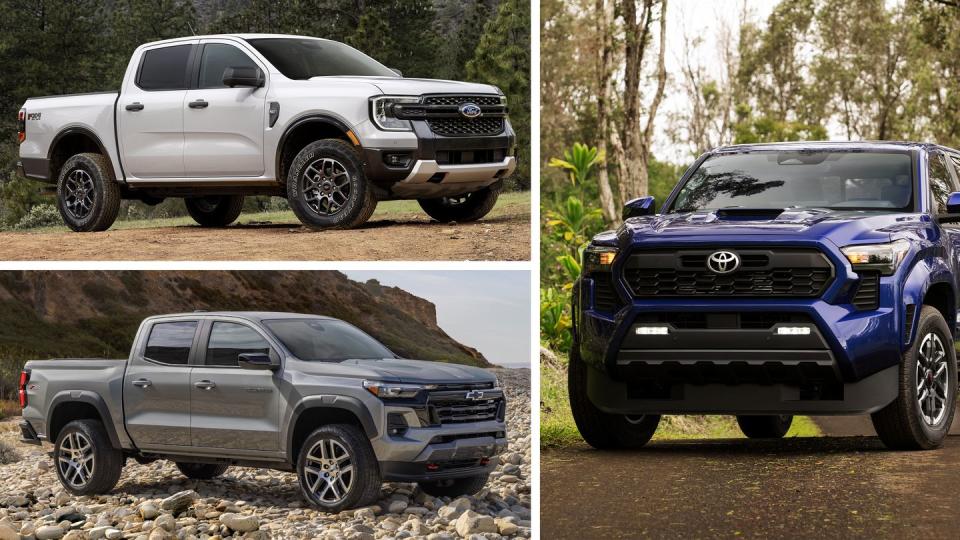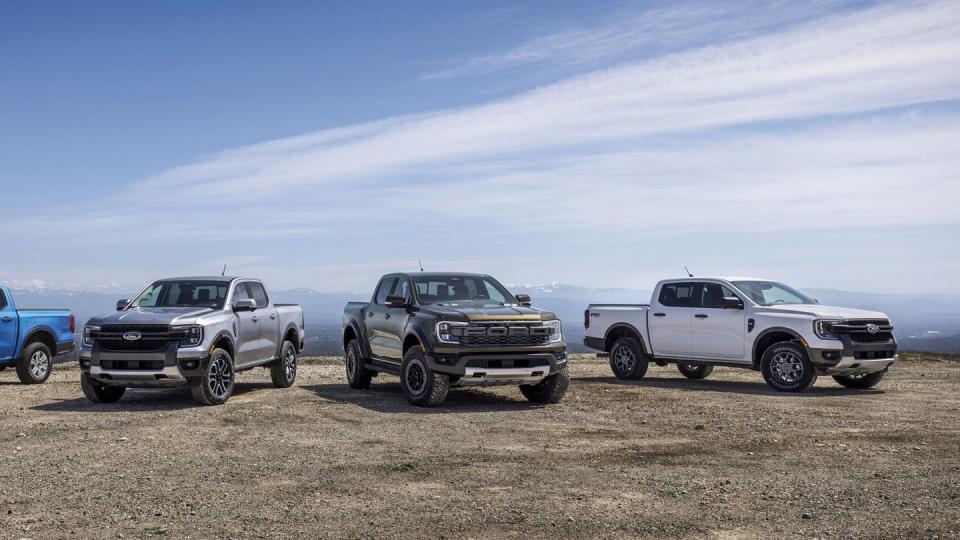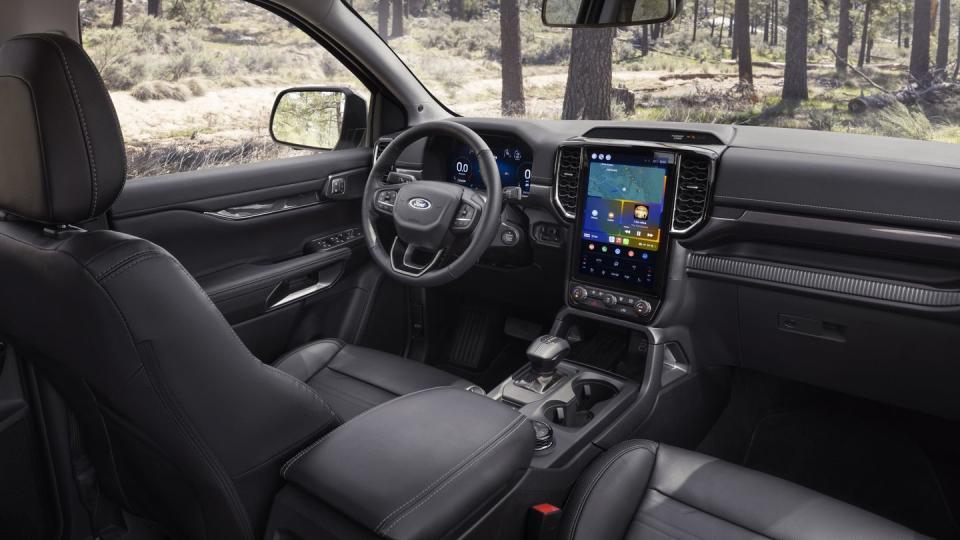2024 Toyota Tacoma vs. Ford Ranger vs. Chevy Colorado: How They Compare

Consider it divine providence that the entire mid-size pickup truck segment is all-new at exactly the same time. The Chevrolet Colorado, Ford Ranger, and Toyota Tacoma have all entered new generations within the last year. This segment was full of ho-hum old metal for a long time, so it's time to line these trucks up and see how their early specifications compare.

Powertrain
The base Tacoma SR comes with a turbocharged 2.4-liter inline-four gas engine making 228 horsepower and 243 pound-feet of torque, mated to an eight-speed automatic transmissions. Moving up into other trims increases the engine output to 278 horsepower and 317 pound-feet; however, opting for the six-speed manual drops those figures to 270 and 310, respectively. Buyers can also electrify themselves with a 2.4-liter hybrid powertrain that boosts output to 326 horsepower and 465 pound-feet.

The Chevy Colorado also comes with three powertrain options, all of which are based on a turbocharged 2.7-liter I-4 and an eight-speed automatic. The base configuration produces 237 horsepower and 259 pound-feet, while the Turbo Plus setup hikes those figures up to 310 and 390. The Turbo HO (High Output) powertrain, which is standard on ZR2 and optional elsewhere, uses software to push the torque even higher, to 430 pound-feet.
The 2024 Ford Ranger comes with two non-Raptor powertrain options, both of which mate to a 10-speed auto. The base turbocharged 2.3-liter I-4 makes 270 horsepower and 310 pound-feet, while opting for the beefier 2.7-liter V-6 will grant you 315 horses and 400 twists. The more hardcore Ranger Raptor bulks up even further, with a 3.0-liter V-6 making 405 horsepower and 430 pound-feet.

Towing and Hauling
Almost every Tacoma can tow up to 6500 pounds. The base-level SR is the outlier, as its only rated to pull up to 3500 pounds, and hybrids max out at 6000 pounds. As for the truck's payload capacity, it ranges between 1230 and 1709 pounds with the gas-fed 2.4-liter turbo four. While its peak payload rating increased from 1638 pounds versus the previous generation, its peak towing capacity is down from 6800 pounds.
Chevrolet's Colorado can tow a bit more, but it hauls a bit less. Nearly every trim can tow up to 7700 pounds, although the base WT and LT trims require options to do so; the ZR2 only manages 6000 pounds, same as the Tacoma hybrid. WT and LT Colorados can haul the most, at 1684 pounds, with Trail Boss and Z71 trims capable of 1587. The ZR2 is clearly not meant for hauling as much, as it can only muster 1151 pounds out back.
The story is similar with the Ford Ranger, although its capability is broken down by drivetrain. Both two- and four-wheel-drive variants can tow 7500 pounds, with 4x2 models hauling 1805 pounds and 4x4 models just below that at 1711. The Ranger Raptor is a little less capable, with a 1411-pound payload capacity and a max towing weight of 5510 pounds.
Suspension and Brakes
The 2024 Tacoma is littered with new suspension bits across the lineup. SR, SR5 XtraCab and TRD PreRunner variants continue to run leaf springs in the rear, but other trims pick up a multilink suspension instead. Different grades have different shocks: TRD Off-Road sports Bilstein monotubes with remote reservoirs, TRD Pro wears Fox adjustable internal-bypass shocks, while Trailhunter rocks ARB's Old Man Emu monotube shocks. If you're after more on-road comfort, the Limited variant uses Toyota's adaptive dampers.
Things are a bit simpler on the Colorado. Non-ZR2 models sport twin-tube shocks with rear leaf springs. As before, the ZR2 upgrades to Multimatic's DSSV dampers. That's it. Nice and easy.
The Ford Ranger isn't any more complex. Standard models come with rear leaf springs and outboard shocks. The Ranger Raptor uses a coil-over setup with adaptive Fox Live Valve dampers, and the rear ditches the leaf springs in favor of a Watts-style getup with trailing arms.
All three trucks now come standard with four-wheel disc brakes. Welcome to the future, Toyota.
Off-Road
When it comes to off-road-specific specifications for the Tacoma, the TRD Pro offers 9.5 inches of ground clearance and 11 inches of running ground clearance; in addition, it offers a 33.8-degree approach angle, a 23.5-degree breakover, and a 25.7-degree departure angle. Non-TRD Pro models have up to 10.7 inches of running ground clearance, with approach, breakover, and departure angles of up to 34.4, 25.5, and 22.1 degrees, respectively.
The Colorado offers between 7.9 (WT, LT) and 9.5 (Trail Boss) inches of ground clearance, rising to 10.7 inches on the ZR2. The Z71 offers 29.1-degree approach, 19.5-degree breakover, and 22.3-degree departure angles; the Trail Boss is a little better at 30.5, 21, and 22.4 degrees, respectively. The ZR2 is obviously the king of the trims—approach is a meaty 38.3 degrees, breakover is 24.6 degrees and departure is 25.1.
Ford also uses running ground clearance, which measures 8.8 inches on rear-drive models and 9.3 inches with four-wheel drive, rising to 10.7 inches on the Raptor. 4x2 Rangers offers 29.2-degree approach, 21.8-degree breakover, and 25.1-degree departure angles, improving to 30.2 degrees, 23.0 degrees, and 25.8 degrees (respectively) in 4x4 guise. The Raptor has them both beat, though; the angriest Ranger promises a 33.0-degree approach, 24.2-degree breakover, and 26.4-degree departure.
Size and Weight
The Taco comes in both two-door and four-door variants, with the former offering a six-foot bed and the latter offering a choice of five- or six-foot beds. The Colorado's five-foot-two-inch bed is all Chevy offers, and the Ranger's sole bed comes in at five feet even.
The Ranger's 128.7-inch wheelbase is a bit less than the Colorado's 131.4-inch span, but the Tacoma tops them both at 131.9 inches. The latter measurement applies to the extended cab with the six-foot bed and the crew cab with the five-foot bed; the crew cab with the six-foot bed has 145.1 inches between its axles. The Colorado is the tallest of the three. Inside, headroom is nearly even between the Ranger and Colorado, as is rear legroom. The Tacoma trails both with between one and two inches less front-seat headroom; crew-cab models add a back seat with similar headroom but 33.7 inches of legroom, which is about an inch less than the others.
However, curb weights couldn't be more different—the Ranger's manufacturer estimates range from 4203 to 4415 pounds, while the Colorado ranges from 4716 to 4971 pounds. The off-road variants are pretty close, though, with Colorado ZR2 weighing 5298 pounds to the Ranger Raptor's 5325. As for the Tacoma, its curb weights range from 4145 to 4720 pounds. However, those figures don't include hybrid-equipped models or the Trailhunter and TRD Pro.

Tech
The 2024 Toyota Tacoma's lower grades get a seven-inch gauge cluster and an eight-inch infotainment display, with higher grades growing to include a 12.3-inch digital gauge display and a 14-inch center touchscreen. Wireless smartphone mirroring is available, while three USB-C ports are offered in the front row, with the option to add more for rear-seat passengers. Keyless start is standard, and with the connected-car subscription enabled, certain devices can use a completely digital key.

The Ranger's tech offerings are slightly larger on base models, with an eight-inch digital gauge cluster and a 10.1-inch central display standard, each growing to a respective 12.4 inches. Chevrolet has democratized its tech a little better, with every variant receiving the same 11.3-inch infotainment touchscreen with standard wireless smartphone mirroring.

Price
While all three vehicles are new, only one is actually on sale as of this writing. A base 2024 Ranger XL will set you back $35,755, while the Raptor is a bit dearer at $58,555. A base two-wheel-drive Colorado WT will run you $30,695, while the 2WD LT will set you back $33,095. Stepping up to the beefier Trail Boss brings the total to $38,495, with the Z71 asking $41,395. At the top of the lineup, the hardcore ZR2 can be had for $48,295, a relative bargain over the Ranger Raptor.
The 2024 Tacoma lineup starts at $32,995 for the entry-level SR with an extended cab and rear-wheel drive. Four-wheel drive adds another $3200, and the crew cab increases the base truck's bottom line by $2200. The SR5 opens at $37,695 in its default configuration, the rear-drive-only TRD PreRunner starts at $39,595, the TRD Sport and TRD Off-Road start at $40,895 and $43,295, respectively, and the Limited's base price is $53,595. Pricing for the Trailhunter and TRD Pro will exceed that and could even approach the $65K mark.
You Might Also Like

 Yahoo Autos
Yahoo Autos 